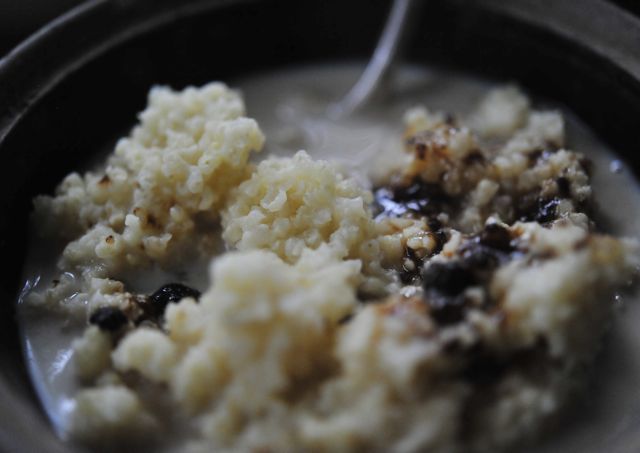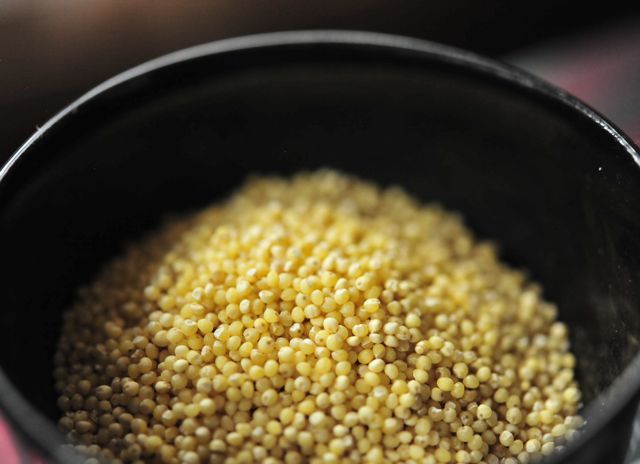2.17.11 Cereal Killers
As in bleached, refined, high-heat-processed, denatured, extruded and packaged breakfast cereals. You know the cutesy O's and puffs and crisps we all grow up eating? Poison. In reading Nourishing Traditions, Sally Fallon's excellent, information-packed guide to eating and cooking for maximum health and nutrition (and enjoyment!), I learned something that I had sort of intuited already but that still seemed shocking when I really understood the facts: the extreme processing to which much packaged food is subjected not only robs what we eat of essential nutrients but can actually be toxic to us. It's particularly true for grains and nuts, which contain fragile oils that turn rancid, and thus harmful, when subjected to heat. That's what makes breakfast cereals so bad for you. The grains are totally broken down and then extruded at extremely high temperatures; ever notice how little they resemble any actual food? Even those "healthy" boxed cereals should be ruled out, including granola and rolled oats. For the most part, convenience foods are not at all convenient for our bodies. As easy as it is to dump some Cheerios and homogenized milk into a bowl, it takes just 15 minutes more to cook up a breakfast that actually has some nutritional value.
Since he turned "vegan before 6pm," Mark Bittman has come up with all sorts of alternative breakfast ideas. You may not be ready yet for a vegetable stir-fry, but there are loads of grains you might not think of right off the bat. Like polenta, brown rice, amaranth, barley, quinoa and millet. Millet, a grain from a hardy grass, was a staple in the human diet long before rice and wheat came to dominate the world's table. Even today, this ancient grain sustains a third of the world's population, primarily in the hot, dry parts of Africa and Asia. One of my favorite discoveries on my trip to India were little rustic flatbreads, bajra ke roti, made from millet flour.
Millet is hulled, but the bran remains intact, and it still manages to be soothing and easy to digest. In addition to phosphorus, B vitamins and iron, this wonderful grain is high in lysine, an essential amino acid.It has 3 grams of protein per cup and it's a rich source of magnesium, a mineral that acts as a co-factor for more than 300 enzymes, including enzymes involved in the body's use of glucose and insulin secretion.
As with quinoa, I like to toast millet in a dry skillet for about 3 minutes to bring out its nutty flavor before cooking it in water. To cook 1 cup of raw millet, combine it in a pan with 2 1/2 cups water and bring to a boil. Cover pot with a tight lid, reduce heat to medium-low and cook 15 minutes. Remove the pot from heat and let it sit uncovered for 15 minutes for optimum flavor and texture. To cook it to a softer texture similar to mashed potatoes, increase the water to 3 1/2 cups and simmer, covered, until water is absorbed, 45 minutes to 1 hour. You can then press this warm mush into a lightly oiled baking dish, cool it, and slice it like polenta.
For breakfast, try cooking a banana or some grated apple with your millet. You can also substitute some milk (cow, soy, almond, coconut or hemp) or even fruit juice for all or some of the water. Sprinkle on some dried coconut, chopped nuts or raisins. Drizzle with maple syrup or honey.
Some other cooked cereal ideas:
steel cut oats with grated apple, buttermilk and dark muscovado sugar
polenta with dried cherries and pine nuts
brown rice with orange and ginger
sticky rice with banana, coconut milk and macadamia nuts
barley with blueberries, almond milk and honey
Millet is hulled, but the bran remains intact, and it still manages to be soothing and easy to digest. In addition to phosphorus, B vitamins and iron, this wonderful grain is high in lysine, an essential amino acid.It has 3 grams of protein per cup and it's a rich source of magnesium, a mineral that acts as a co-factor for more than 300 enzymes, including enzymes involved in the body's use of glucose and insulin secretion.
As with quinoa, I like to toast millet in a dry skillet for about 3 minutes to bring out its nutty flavor before cooking it in water. To cook 1 cup of raw millet, combine it in a pan with 2 1/2 cups water and bring to a boil. Cover pot with a tight lid, reduce heat to medium-low and cook 15 minutes. Remove the pot from heat and let it sit uncovered for 15 minutes for optimum flavor and texture. To cook it to a softer texture similar to mashed potatoes, increase the water to 3 1/2 cups and simmer, covered, until water is absorbed, 45 minutes to 1 hour. You can then press this warm mush into a lightly oiled baking dish, cool it, and slice it like polenta.
For breakfast, try cooking a banana or some grated apple with your millet. You can also substitute some milk (cow, soy, almond, coconut or hemp) or even fruit juice for all or some of the water. Sprinkle on some dried coconut, chopped nuts or raisins. Drizzle with maple syrup or honey.
Some other cooked cereal ideas:
steel cut oats with grated apple, buttermilk and dark muscovado sugar
polenta with dried cherries and pine nuts
brown rice with orange and ginger
sticky rice with banana, coconut milk and macadamia nuts
barley with blueberries, almond milk and honey








0 Comments